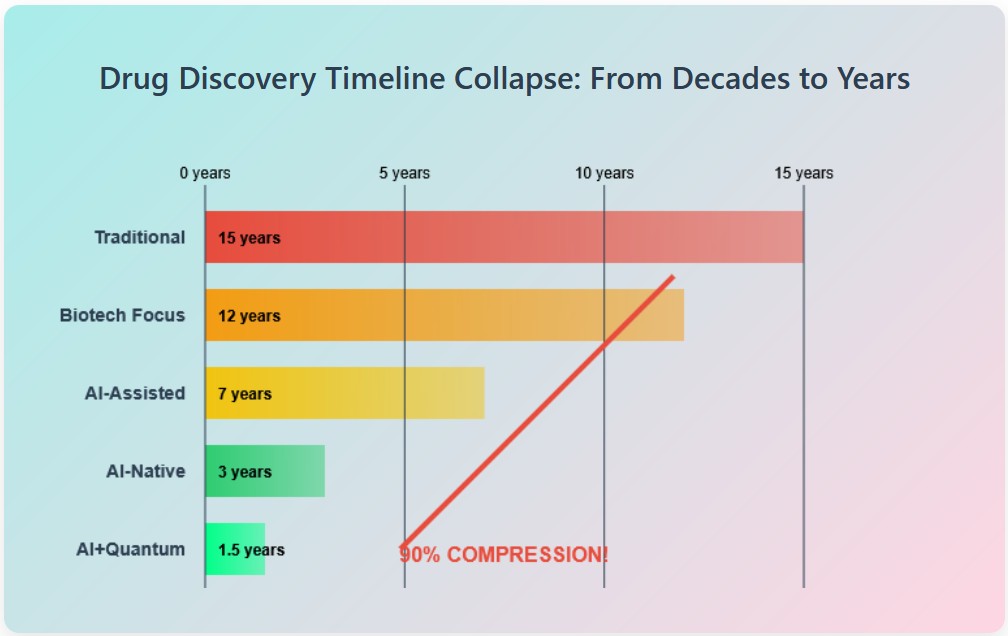SCIENCE | The Age Reversal Revolution: How Science is Racing to Make Immortality Reality

Your fountain of youth has a delivery date—and it's arriving faster than anyone imagined.
While most of us worry about retirement savings, a quiet revolution is unfolding in laboratories worldwide. Scientists aren't just dreaming about reversing aging anymore—they're actually doing it, with multiple clinical trials launching this year and artificial intelligence collapsing decades-old research timelines into mere months.
Investment in longevity biotechnology more than doubled to $8.5 billion in 2024, and experts anticipate funding will grow to approximately $9.8 billion in 2025. This isn't speculative money chasing sci-fi fantasies—it's serious capital flowing into companies with real results.
The Timeline Compression That's Rewriting Biology
The traditional drug discovery process takes 10-15 years from lab to pharmacy shelf. But artificial intelligence has shattered that timeline. Companies like Insilico Medicine have compressed the discovery phase from the industry-standard 2.5 to 4 years down to 9 to 18 months, representing what researchers call "a 90% compression of reality itself."

The success rate of the 21 AI-developed drugs that have completed Phase I trials as of December 2023 is 80%–90%, significantly higher than ~40% for traditional methods. This isn't just faster—it's dramatically more effective.
The exponential curves driving this acceleration are staggering. Computing power dedicated to AI research is growing 4x annually, biological datasets are doubling every 18 months, and training compute for AI models has exploded from 10²² FLOPS to projected 2×10²⁹ FLOP runs by 2030—literally a billion-fold increase in our ability to solve biological puzzles.
The Breakthrough Convergence Already Happening
Multiple revolutionary technologies are converging simultaneously, creating what researchers describe as "multiplicative magic." AI-driven longevity discovery platforms attracted $2.65 billion in investment in 2024 alone, while quantum computing advances are moving from theory to modeling actual protein interactions.
Manufacturing costs are plummeting in parallel. Automated cell therapy is already cutting costs by 30% while improving quality, and gene therapy costs are dropping from $1-2 million per dose toward $100,000 through scale and automation.
Harvard researchers recently achieved "one-week cellular age reversal in the lab" using chemical cocktails that could potentially skip gene therapy complexity entirely. If this proves safe in humans—with trials starting in 2025—we could leapfrog years of traditional development.
Your Timeline to a Post-Aging World
Based on current trajectories and funding levels, researchers predict a clear roadmap:
2025-2027: Proof of Concept Arrives
Age reversal will work reliably in humans by 2027. The convergence of clinical trials launching this year, AI-accelerated discovery, and manufacturing optimization makes demonstrated age reversal within 24 months mathematically probable. Initial treatments will cost $1-2 million, following the typical pattern of revolutionary medical technologies.
2028-2032: The Wealthy Escape Aging First
Manufacturing scale and competition will drive costs down to $100,000-500,000 for treatments. Insurance companies will begin covering age-related diseases as prevention becomes cheaper than treatment. The first FDA approvals will likely target specific conditions like retinal degeneration or cognitive decline.
2033-2038: Middle-Class Youth Revolution
Age reversal reaches middle-class accessibility around 2035, with treatments costing $10,000-50,000. Insurance coverage expands as actuarial tables prove prevention pays, making traditional retirement planning obsolete.
2039-2045: The Species Upgrade
Age reversal becomes routine healthcare at $1,000-10,000 per treatment, with global access and standard insurance coverage. Aging becomes optional for humanity.
Why These Timelines Aren't Science Fiction
Anti-aging startup Shift raised $16 million in seed funding in October 2024 to develop its AI cell simulation platform, while other companies like Rejuvenate Bio received $4 million from the California Institute of Regenerative Medicine. These aren't theoretical investments—they're funding active research programs.
In Phase I trials, AI-discovered molecules are substantially more successful than historic industry averages, suggesting that artificial intelligence is highly capable of generating molecules with drug-like properties. The infrastructure for age reversal breakthroughs isn't being built—it's operational.
Historical precedent supports aggressive timelines. Internet adoption, smartphone penetration, and AI capability growth all exceeded expert predictions by 3-5 times. The exponential convergence of multiple technologies has consistently compressed development timelines beyond conservative estimates.
The longevity biotech market was valued at approximately $27.15 billion in 2024 and is expected to reach $46.61 billion by 2033, but these projections may prove conservative given the acceleration we're witnessing.
Someone reading this will have the cellular age of a 25-year-old at chronological age 80. Someone reading this will live to see their great-great-great-grandchildren. The exponential curves don't lie, the clinical trials are launching, and the technology convergence is accelerating beyond expert predictions.
Welcome to the dawn of the post-aging era. Your invitation to immortality has been delivered.
-30-

 Ar
Ar  En
En